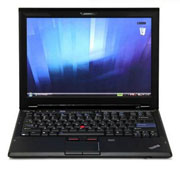 The Lenovo ThinkPad design team has written about just what went into the design and engineering of the Lenovo ThinkPad X300 on their Design Matters blog (LenovoBlogs.com):
The Lenovo ThinkPad design team has written about just what went into the design and engineering of the Lenovo ThinkPad X300 on their Design Matters blog (LenovoBlogs.com):
The Lenovo design and engineering team has been working on this one for well over a year. It started out as a idea: let’s build the most advanced ThinkPad ever, in the thinnest and lightest package possible.
Turns out, they had a journalist involved, who wrote a very comprehensive article about the ThinkPad X300’s design at BusinessWeek:
His secretary, Phyllis Arrington-McGee, ransacked filing cabinets until she found one of the envelopes. She handed it to Hortensius, who gingerly slipped the X300 inside. “It fits! It fits!” he shouted.
Perhaps no one was more relieved than David Hill, Lenovo’s chief designer, who stopped by Hortensius’ office right after the envelope experiment. It had been his idea to create the superthin X300, which was originally code-named Kodachi. Hill shared a laugh about the test with Hortensius and later couldn’t resist a poke at Jobs’ latest creation. “I’m a bit tired of looking at silver computers,” said Hill. “I’d never wear a silver business suit.”
Such is life in one of the most competitive markets on earth: the portable computer business. The best engineers and designers at the most powerful technology companies slug it out with top-secret plans and ulcer-inducing deadlines. From Hewlett-Packard (HPQ) and Dell (DELL) to Acer, Lenovo (LNVGY), and Toshiba, design and production teams race to carve out their share of the fast-growing market. They fight over ounces and millimeters, but their victories are measured in billions of dollars.
For David Hill, Steve Jobs, and others in the fraternity, the questions are: What is the perfect combination of weight, price, and features? And what new technologies should be included? It’s a sign of the intense competition that the revered Jobs received decidedly mixed reviews for Apple’s Air, despite its eye-catching looks.
Turns out, they focused on three things first:
Lenovo’s product development managers were focusing on a new high-end laptop that would include three important emerging technologies. The first was solid-state storage, which doesn’t break when people drop their laptops the way the mechanical disk drives in most computers sometimes do. The second technology was LED backlighting on computer displays, which would improve movie viewing. The third was a DVD drive just seven millimeters thick. In October, 2006, the managers decided to combine these technologies with Hill’s design concepts. The machine was given the code name Kodachi, after a small samurai sword.
One of the best articles written about the industry in a while, and you can read it here (BusinessWeek.com).

